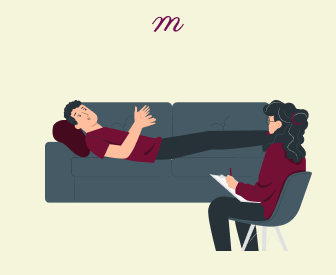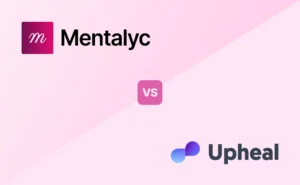You have patients, right? Or do you have clients? As a therapist, the words you choose hold immense power. They shape the nature of your relationships with those you serve. Whether you use the term “clients” or “patients,” each carries its own weight. This weight can influence the dynamics of your interactions and the effectiveness of your interventions. This blog will get into the debate surrounding these two labels. We’ll uncover their historical roots, implications for the therapeutic relationship, and practical considerations for navigating this linguistic landscape. Get ready to take an exhilarating ride as we explore the incredible influence of language in therapy.
Exploring “Client” vs. “Patient” in Therapy
When it comes to therapy, understanding the difference between “client” and “patient” is crucial for therapists looking to build collaborative and empowering relationships with their clients. By exploring the historical context and evolution of these terms, we can gain a deeper understanding of their implications on therapy dynamics and the role of language in shaping them.
Historical Context and the Evolution of Terminology
Over time, mental health care has undergone significant changes, which have led to a shift in the language used to describe it. The traditional term “patient” implies a passive role for the individual seeking treatment and reinforces a hierarchical relationship where the therapist is viewed as the sole expert. However, as mental health practices have evolved towards more collaborative and person-centered approaches, the term “client” has emerged as a more appropriate alternative.
This shift in language represents a fundamental change in therapy dynamics, emphasizing the individual’s active participation and engagement in their treatment journey. Using the term “client,” therapists acknowledge each person’s autonomy, agency, and inherent capacity for growth and self-determination. This departs from the traditional notion of individuals as passive treatment recipients, positioning them as equal partners in the therapeutic process.
Navigating Language Choices in Therapy: Implications, Considerations, and Best Practices
Language plays a crucial role in therapy, impacting the relationship between therapists and clients and treatment outcomes. The choice between “client” and “patient” is a topic of ongoing debate, as it reflects deep philosophical and ethical considerations. While some therapists prefer “patient” for its perceived professionalism, others opt for “client” for its empowering and person-centered approach.
In therapy, language choice goes beyond the immediate therapeutic relationship and has broader social and cultural implications. Therapists must be mindful of how their words may reinforce or challenge stigmas surrounding mental health. By using inclusive and empowering language, therapists can enhance therapeutic relationships and work towards dismantling societal barriers to accessing mental health care. Ultimately, the goal is to promote inclusivity and empowerment in therapy, which can lead to more favorable treatment outcomes and a healthier society.
The following explores practical strategies and considerations for therapists when navigating the complexities of language choices in therapy:
Empowerment and Trust:
Opting for “client” over “patient” underscores the individual’s agency and autonomy in the therapeutic process, fostering trust and collaboration. “Client” frames the relationship as a partnership between equals, encouraging openness and active participation. In contrast, “patient” may imply a power imbalance and evoke associations of illness or hospitalization, potentially impeding therapeutic progress.
Cultural Sensitivity:
Recognizing that an individual’s cultural background and values can significantly influence how they perceive language used in therapy is essential. The term “patient” may have negative connotations for some populations, while “client” could be more inclusive and culturally sensitive. Therefore, therapists should always be mindful of their clients’ backgrounds and preferences to promote inclusivity and respect. Choosing culturally sensitive and inclusive language is crucial to building a solid therapeutic relationship.
Philosophy of Practice:
Therapists must consider their therapeutic philosophy and approach in their language choices. For example, humanistic or existential therapists may prefer to use the term “client” to emphasize collaboration and personal growth, while psychodynamic or medicalized approaches may lean towards “patient.” Still, it is vital to ensure that language aligns with the therapist’s values and resonates with their clients to create a positive and constructive therapeutic relationship
Different Settings and Common Terms in Mental Health Treatment
Depending on their training, specialization, and practice context, professionals may use different terminology in various mental health treatment settings, including hospitals, community health centers, and private practices.
Psychiatrists:
Psychiatrists are medical doctors who specialize in mental health care. They work in clinical settings such as hospitals, outpatient clinics, or private practices. They may use the term “patient” to refer to the individuals they treat, which aligns with the diagnostic and treatment aspects of psychiatric practice.
Psychiatric Nurses:
Psychiatric nurses work alongside psychiatrists and other mental health professionals in various healthcare settings, including hospitals, community health centers, and residential treatment facilities. While they may also use the term “patient” in psychiatric nursing documentation and medical discussions, they often use terms like “clients” or “consumers” when interacting directly with individuals seeking mental health support.
Therapists and Counselors:
Therapists and counselors, including psychologists, social workers, and licensed professional counselors, provide psychotherapy and counseling services in diverse settings such as private practices, community mental health centers, schools, and online platforms. These professionals typically use the term “client” to describe the individuals they work with, emphasizing empowerment, autonomy, and mutual respect in the therapeutic relationship.
Improving Therapeutic Communication: Choosing Language with Sensitivity and Flexibility
Effective therapeutic communication is crucial for fostering positive outcomes in therapy. Language choices are critical in shaping the therapist-client relationship and can significantly impact the treatment experience. Although there might be ongoing debates about specific terms to use, therapists must approach language choices with sensitivity and flexibility, being mindful of the implications of their words on clients‘ experiences and outcomes.
Therapists can create a safe and collaborative environment that promotes healing and growth by prioritizing respect for clients’ autonomy and cultural sensitivity. It’s essential to consider the diverse perspectives and values within the therapy community and stay updated with professional guidelines to ensure ethical practice. Ultimately, thoughtful consideration and flexibility in language use can help therapists establish stronger connections with their clients and achieve better therapeutic outcomes.
Practical Strategies for Therapists
As therapists, we can approach the terminology dilemma constructively by prioritizing our clients’ individual needs and preferences. Here are some practical strategies to consider:
- Stay Flexible: We must recognize that clients come from diverse backgrounds, experiences, and cultural contexts, which may influence their language preferences. Therefore, it is essential to remain open-minded and willing to use terms like “client” or “patient” based on each client’s unique needs and preferences.
- Engage in Open Dialogue: It’s crucial to communicate openly with our clients regarding language choices and invite their feedback. Explaining the rationale behind our preferred terminology allows us to explore alternatives that may better resonate with their experiences and identities.
- Offer Multiple Options: It’s vital to consider presenting alternative terms to “client” and “patient” when working with individuals seeking therapy. By offering a range of options, you can empower clients to choose the terminology that best reflects their sense of self and agency. Some potential alternative terms to consider include:
- Individual: This term emphasizes the unique identity and autonomy of each person seeking therapy.
- Person: Using “person” can promote a more humanizing and inclusive approach.
- Participant: This term suggests active involvement and collaboration in the therapeutic process.
- Partner: Referring to individuals as “partners” highlights the collaborative nature of the therapeutic relationship.
- Seeker: “Seeker” conveys the idea of actively seeking support and guidance on one’s journey toward well-being.
- Collaborator: Emphasizing the role of clients as co-creators of their therapeutic experience and outcomes.
- Member: Referring to individuals as “members” acknowledges their belonging to and active participation in the therapeutic community.
- Supportee: This term acknowledges the supportive role of therapy in individuals’ lives and emphasizes their agency in seeking support.
- Adapt to Evolving Preferences: It’s essential to remain open to changes in your clients’ language preferences as their therapeutic journey progresses. As they grow and evolve, their preferred terminology may shift, reflecting changes in their self-perception and therapeutic needs.
- Educate and Normalize: Take the opportunity to educate your clients about the importance of language in therapy and its impact on the healing process. Encourage open discussions about language choice, highlighting its role in promoting empowerment, respect, and collaboration.
To further improve your ability to address language-related challenges in various therapeutic settings, here are some additional techniques you can use:
- Active Listening and Reflective Language: Listen carefully to your clients’ language preferences and use their choice of terminology to validate their experiences and build rapport.
- Collaborative Terminology Development: Work with your clients to co-create a shared language that feels empowering for both parties. Discuss various terms and select ones that resonate with your clients’ identities and therapeutic goals.
- Cultural Proficiency and Sensitivity: Enhance your cultural literacy and sensitivity when working with clients from diverse cultural backgrounds to navigate language-related challenges. Familiarize yourself with your clients’ communication norms and cultural backgrounds, and incorporate culturally appropriate terminology into your practice.
- Language Assessment and Adjustment: Regularly assess the impact of your language choices on therapeutic outcomes and adjust your approach as needed. Solicit feedback from your clients to enhance their engagement and rapport. Reflect on the cultural and social context of therapy sessions to ensure your language is culturally sensitive and inclusive.
- Trauma-Informed Language Practices: Foster a safe and supportive environment for clients with trauma histories by implementing trauma-informed language practices. Use strengths-based language that emphasizes resilience and self-efficacy while avoiding language that may trigger trauma responses or reinforce feelings of powerlessness.
- Client Education and Empowerment: Empower your clients to advocate for their language preferences and assert their autonomy in therapy. Provide resources and information about the significance of language in therapy, encouraging open communication about language choices.
- Supervision and Peer Support: Peer support and supervision to discuss language-related challenges and receive colleague feedback. Peer consultation supervision and group sessions offer opportunities to share experiences, brainstorm solutions, and learn from each other’s perspectives.
Conclusion
As therapists, we hold tremendous power in the words we choose. Every word we use can either uplift or disempower our clients. We must approach our language with inclusivity and flexibility at the forefront of our minds. Rather than sticking to rigid terminology, we should engage in open dialogue with our clients and respect their preferences and identities. By prioritizing inclusivity and honoring our clients’ unique experiences, we can create a therapeutic environment that empowers and uplifts them. Our clients’ needs and humanity should serve as our compass in the therapy room. Let’s strive to build an inspiring alliance with our clients that honors their autonomy and agency through open communication and mutual respect. By remaining flexible, engaging in open dialogue, and prioritizing inclusiveness, we can create a therapeutic environment that uplifts and empowers our clients. Ultimately, it’s not just about the words we use but the relationships we cultivate and our impact on the lives of those we serve.
Looking to make a positive change in your mental health practice? Say goodbye to long hours spent writing progress notes and hello to a more efficient and organized way of working. Take the first step towards optimizing your practice and providing exceptional client care with a free trial of Mentalyc today. Seize the moment and transform your practice for the better!
FAQ: Answering Common Questions on Using “Client” or “Patient” in Therapy
What’s the difference between “client” and “patient”?
As therapists, the words we choose are important. The terms “client” and “patient” have different implications. “Client” suggests a collaborative relationship where the individual seeks our professional expertise. On the other hand, “patient” implies a more passive role, waiting for treatment from a medical professional. For counselors and therapists, “client” is the preferred term reflecting our non-medical, empowering approach. However, some therapists may prefer to use “patient” to emphasize the seriousness of mental health issues.
Do psychiatrists and psychiatric nurses use the same terms?
Not always. Since doctors work within a medical model, “patient” is the standard term. On the other hand, therapists work outside this model, and the terms they use depend on their professional philosophy and their relationship with the individuals they serve.
How do I decide what’s suitable for my practice?
There’s no universally “right” answer. Considering your therapeutic orientation, professional identity, and core values is important. It is also essential to have open communication with your clients to understand their preferences and what language empowers them. You might use different terms for clients depending on their needs and backgrounds. The most crucial thing is using language that fosters trust, inclusivity, and collaboration.
What are the benefits of using “client”?
Using the term “client” has several benefits. It reinforces a strengths-based, empowering approach. It implies a partnership where you work with individuals seeking your expertise. “Client” also reflects the non-medical nature of therapy and counseling. For some, “patient” carries a stigma or implies they lack agency over their mental health. Using their preferred term shows you respect them as equal partners in the therapeutic process.
What if a client prefers “patient”?
It’s crucial to discuss patients’ preference for the term “patient” or “client.” Some may prefer “patient” as it may make them feel their medical condition is being taken seriously. However, explaining how the term “client” can empower them as active collaborators in their own care is important. The goal is to find a compromise that both parties are comfortable with and to use language that shows respect, understanding, and care. As therapists and counselors, our core values should reflect empowering those we serve, meeting them where they are, and building a collaborative relationship based on trust, understanding, and mutual respect.
References:
Wing, P. C. (1997, August 1).Patient or client? If in Doubt, Ask. PubMed Central. https://www.ncbi.nlm.nih.gov/pmc/articles/PMC1227829/
Borelli, J. L., Sohn, L., Wang, B. A., Hong, K., DeCoste, C., & Suchman, N. E. (2019). Therapist–Client Language Matching: Initial Promise as a Measure of Therapist–Client Relationship Quality. Psychoanalytic Psychology, 36(1), 9-18. https://doi.org/10.1037/pap0000177
White, M. B., Elias, R., & Cooke, D. (2024, March 4).Exploration of the Social and Philosophical Underpinning of ‘the Patient’—What This Means for People with a Long-Term Condition. Nature. https://www.nature.com/articles/s41599-024-02729-8#:~:text=However%20a%202018%20resolution%20by,American%20Psychological%20Society%2C%202018)
Why other mental health professionals love Mentalyc

“It’s so quick and easy to do notes now … I used to stay late two hours to finish my notes. Now it’s a breeze.”
Licensed Professional Counselor

“A lot of my clients love the functionality where I can send them a summary of what we addressed during the session, and they find it very helpful and enlightening.”
Therapist

“By the end of the day, usually by the end of the session, I have my documentation done. I have a thorough, comprehensive note … It’s just saving me hours every week.”
CDCII

“It takes me less than 5 minutes to complete notes … it’s a huge time saver, a huge stress reliever.”
Licensed Marriage and Family Therapist







